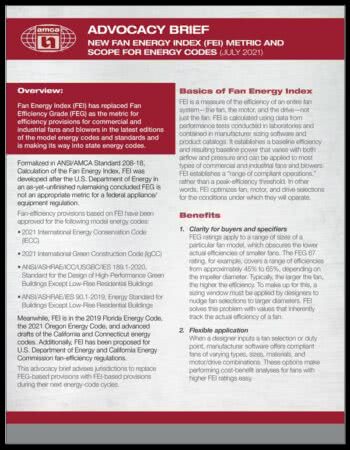
The Fanfare Blowing Around Using FEI or FEG for Energy Efficiency in Buildings
Regulations are complex, especially when designers and architects and other professionals are trying to do the right thing when it comes to energy efficiency.
For example, according to BillTrack50, a software tool that allows you to see and track legislation throughout the US at the state and federal levels, there are 1,207 bills going on right now with the words “energy efficiency” in them. The US Government has 13% of those bills (the most), and along with seven other states (NY, NJ, MA, VA, MN, IL, CA) comprise over 50% of current energy efficient legislation.
In other words, 42 states have less than half of the legislation on energy efficiency in play right now.
But “energy efficiency” per se can be interpreted in many different ways, and therein lies the complexity when it comes to designing and specifying for efficiency.
Take Fans.
The US Department of Energy’s Better Buildings® publishes a lot of information about fans which are widely used in industrial and commercial applications for energy effieiency. And so does the Air Movement and Control Association (AMCA) International Inc., a not-for-profit association of manufacturers of fans, dampers, louvers, air curtains, and other air-system components for commercial HVAC, industrial-process, and power-generation applications.
And AMCA should know, since they offer programs such as certified ratings, laboratory accreditation, verification of compliance, and international-standards development to advance the health, growth, and integrity of the air-movement-and-control industry consistent with the interests of the public.
To FEI or FEG, that is the Question
Recently, AMCA issued new information which guides us to sort through some of the regulatory complexity when it comes to fan standards, which concerns designers when it comes to their involvement in commercial and industrial buildings. The information was in regards to using the Fan Efficiency Grade (FEG) FEG or Fan Energy Index (FEI) as a guide. Here is what AMCA tells us for your reference.
AMCA Introduces Tools to Aid States’ Transition to Fan Energy Index
ARLINGTON HEIGHTS, Ill., Aug. 2, 2021—On July 28, the U.S. Department of Energy (DOE) issued determinations that the 2019 edition of ANSI/ASHRAE/IES 90.1, Energy Standard for Buildings Except Low-Rise Residential Buildings, and the 2021 edition of the International Energy Conservation Code (IECC) “will achieve greater energy efficiency in buildings subject to the code” and “will improve energy efficiency in residential buildings,” respectively. Upon publication of these affirmative determinations, the DOE says, states must review and certify their building codes relative to ANSI/ASHRAE/IES 90.1-2019 and the 2021 IECC.
As states begin to examine and update their energy codes, some are adopting an earlier edition of ANSI/ASHRAE/IES 90.1 (2016 or 2013) or the IECC (2018 or 2015). In so doing, they are prolonging the use of fan efficiency grade (FEG) as the metric for efficiency provisions for commercial and industrial fans and blowers[1].
FEG, which the DOE concluded in an as-yet-unfinished rulemaking is not an appropriate metric for a federal appliance/equipment regulation, was replaced by fan energy index (FEI) for ANSI/ASHRAE/IES 90.1-2019 and the 2021 IECC. Air Movement and Control Association (AMCA) International Inc. advises states adopting earlier editions of ANSI/ASHRAE/IES 90.1 and the IECC to “leapfrog” the outdated FEG metric to take advantage of the energy-saving, compliance-easing FEI.
For example, Florida, which on Dec. 31 became the first state to adopt FEI when the seventh (2020) edition of Florida Building Code: Energy Conservation was published, adopted the 2018 IECC, but the 2021 IECC fan-efficiency provision.
 “Florida has set the example of how to leapfrog model-energy-code provisions to avoid prolonging the use of an outdated metric,” AMCA International Senior Manager, Advocacy, Aaron Gunzner said. “To help other states achieve the goal of phasing in the new FEI metric, AMCA International has, with permission from ASHRAE and the International Code Council, developed templates[2] with exact strike-out/underline language.”
“Florida has set the example of how to leapfrog model-energy-code provisions to avoid prolonging the use of an outdated metric,” AMCA International Senior Manager, Advocacy, Aaron Gunzner said. “To help other states achieve the goal of phasing in the new FEI metric, AMCA International has, with permission from ASHRAE and the International Code Council, developed templates[2] with exact strike-out/underline language.”
Additionally, to describe the rationale for and the benefits of changing metrics, AMCA International recently updated its Advocacy Brief: New Fan Energy Index (FEI) Metric and Scope for Energy Codes, a document for code officials and others considering proposals to transition from FEG to FEI.
Formalized in ANSI/AMCA Standard 208-18, Calculation of the Fan Energy Index, FEI considers the effects of motors and drives, not just fans, and aids the right-sizing of fan systems for the conditions they will operate in. In addition to ANSI/ASHRAE/IES 90.1-2019 and the 2021 IECC, FEI has replaced FEG in:
- 2021 International Green Construction Code (IgCC)
- ANSI/ASHRAE/ICC/USGBC/IES 189.1-2020, Standard for the Design of High-Performance Green Buildings Except Low-Rise Residential Buildings
____________________________________
In other words, AMCA makes it easier for states and the federal government to get it right the first time. And that’s what energy efficiency is all about, isn’t it?
For more information about AMCA’s positions, contact: Robb Clawson, Director, Education, Marketing & Communications, [email protected] +1 847-704-6325
_________________________________________________________________
[1] EDITOR’S NOTE: What’s interesting is that in the 1,207 bills going on right now, only 36 contain the word “fan,” and only 20 contain fan and “ANSI.” In fact, none of the bills reference FEG or FEI, which begs the question of how information is shared these days. Piling on legislation on top of legislation (amending) leads to the growing complexity around us, and reminds us to “get it right the first time” or as they do in construction, “measure twice, cut once.”
[2] To download the templates and to view Advocacy Brief: New Fan Energy Index (FEI) Metric and Scope for Energy Codes, go to AMCA International’s FEI microsite at www.amca.org/FEI. The microsite additionally includes links to related codes and standards, technical articles and white papers, webinar recordings, and presentations.
About AMCA International. Air Movement and Control Association (AMCA) International Inc. is a not-for-profit association of manufacturers of fans, dampers, louvers, air curtains, and other air-system components for commercial HVAC, industrial-process, and power-generation applications. With programs such as certified ratings, laboratory accreditation, verification of compliance, and international-standards development, its mission is to advance the health, growth, and integrity of the air-movement-and-control industry consistent with the interests of the public. For more information about AMCA, visit www.amca.org.